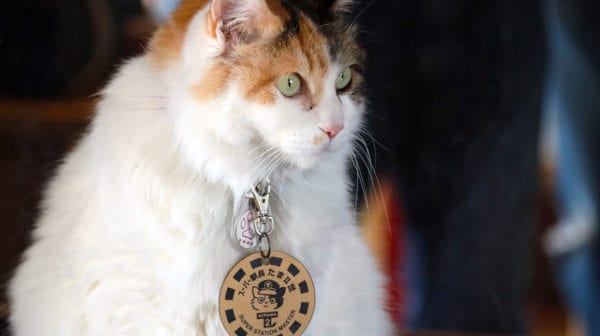Over the years I have treated many cats for shaking – whether they were shaking their head, feet, tail, or the whole body, while asleep or when being petted and purring. Because shaking can be a very general sign, there can be many reasons for shaking in cats.
What To Watch For
Shaking in an adult cat can be generalized, involving the entire body, or more localized, involving the head, tail or other body part. The condition can come on suddenly or gradually, depending on the cause, and it may not happen often, or it may occur more frequently.
If the shaking or tremors are involuntary, what you will observe are repetitive muscle movements that alternate between contraction and relaxation, usually involving either rapid or slow movements (twitching) of one or more body parts.
As the causes can be numerous, it may be difficult to determine exactly why your cat is shaking.
Medical Causes Of Shaking In Cats
It may not be obvious that the shaking is a symptom of a medical condition, which may have significant adverse consequences, so shaking should not be ignored. Though it is helpful for you to have a better understanding of why your cat is shaking, I always recommended that you contact your veterinarian immediately to begin the process of determining the cause(s). In general, your veterinarian should always be contacted whenever your cat demonstrates behaviors that are abnormal.
Possible causes of shaking can be:
- Genetic
- Congenital (present at birth)
- Trauma or injury
- A side-effect of medications or toxins
- Infections
- Metabolic disorders, including liver or kidney disease
- Abnormal levels of blood sugar, calcium, potassium or other metabolites
- Inflammation or severe pain
- Disease involving the nervous system
- Idiopathic (unknown cause)
To try to determine the cause, your veterinarian will likely want to review your cat’s complete medical history as well as get a thorough background of the symptoms, the time of onset, and possible incidents that might have led to this condition. He or she will also perform a complete physical exam on your cat. As part of the complete exam, a lab evaluation of your cat would include a complete blood count, biochemistry profile including an electrolyte panel, and an urinalysis.
If the cause of the shaking involves the central nervous system, then the initial laboratory tests may be found to be within normal limits. Other diagnostic tests may then be performed. These may include X-rays, magnetic resonance imaging (MRI), and computed tomography (CT-Scan), especially in cases where the extremities are involved. These evaluations may reveal abnormalities in the brain or spinal cord. In these patients, collection of cerebrospinal fluid (CSF) may be beneficial to better determine the exact cause of the shaking. A myelogram (study of the spine using dye) may be recommended to assess for the presence of tumors or disc disease. And electromyelography (EMG) may also be beneficial in the diagnosis of associated neuromuscular disorders.
For your information and to better understand the causes of shaking, here is a more in-depth look at some examples of conditions that can result in shaking. However, you should still contact your veterinarian immediately.
Hypoglycemia
Hypoglycemia, a decreased sugar level in the blood, is one of the more common causes of shaking or tremors in cats. If a cat has not eaten for an extended period of time, this can result in a lowering of the blood sugar, and the resulting hypoglycemia can lead to shaking. To correct this low blood sugar, one should administer a source of energy, be it cat food, honey, maple syrup, etc., immediately, to promote an increase in the glucose levels in the blood. If your cat is unable to eat on its own, you can very carefully try to rub the syrup or honey on the cat’s gums to facilitate the sugar’s entry into the blood stream as rapidly as possible. However, your veterinarian should be contacted immediately for further care recommendations. As low blood sugar may be present even if your cat eats properly, you should always take your cat to the vet for a thorough evaluation.
Low Body Temperature
A low body temperature in a cat can result in shaking. The normal body temperature of a cat is between 100.5 to 102.5 degrees Fahrenheit. Adult cats can manage to maintain a normal core body temperature even in lower temperatures, but kittens — especially newborns — will have trouble maintaining a normal temperature, and this may become life-threatening. Disease – either acute or chronic – may also lead to hypothermia. It is therefore very important to keep your cat warm by providing additional blankets or a heating pad while contacting your veterinarian.
Hyperthermia
At the same time, hyperthermia, fever or elevated body temperature in cats, which may occur due to viruses, infections or other illnesses, can lead to shaking. Any temperature above 102.5 degrees Fahrenheit equals a fever in a cat. This elevated body temperature may cause shaking or tremors in felines. If you are concerned that your cat may have a fever, checking your cat’s temperature with a thermometer and passing this information onto your veterinarian may speed up the recovery and prevent further complications.
Pain
Pain, whether the cat has an injury or an internal illness, may result in shivering or trembling in felines.
Seizures
Seizures may also result in muscular tension and trembling. Theses seizures may occur for a number of reasons, including heat stroke, toxicity, metabolic diseases, fever, epilepsy, allergic reactions or medication overdose.
Shock
Shock may also trigger trembling and shivering in cats. Shock may occur due to a severe illness after an accident or trauma. Other signs of shock include cold limbs, pale gums, weakness and a rapid heart rate.
Ear Issue
Head shaking by itself, or along with scratching at its ears, is a common sign of an ear problem. Your veterinarian can determine if it is an infection, e.g. bacterial, yeast and/or mites, or something involving another aspect of the middle or inner ear.
Deep Sleep
Cats can also twitch during sleep. Felines cycle in and out of light and deep sleep. It is during the deep sleep stage, which may only last for six to eight minutes, that your cat will be in a deep sense of relaxation. During these few minutes, your cat may twitch or quiver. Though this shaking should be noted, monitored and discussed with your veterinarian, it usually is just a normal occurrence during those periods of deep sleep.
Behavioral Causes For Shaking In Cats
There are also behavioral causes for shaking and trembling in adult cats. Stress, anxiety, fear or phobias may trigger shivering in felines. These are physiological bodily responses by your cat to his mental state.
Most these behavior issues develop at the onset of social maturity (12 to 36 months old). A profound form of fear and withdrawal of unknown cause often occurs around eight to ten months of age. Old-age-onset separation anxiety of unknown cause may be a variant of a decline in thinking, learning and memory in elderly pets.
Anxiety
Anxiety is the anticipation of future dangers from unknown or imagined origins that result in physiologic reactions associated with fear. Some of the most common visible behaviors are elimination (urination and/or passage of bowel movements), destruction, and excessive vocalization (meowing) and/or shaking/trembling.
Fear
The definition of fear is the instinctual feeling of apprehension resulting from a situation, person, or object that appears to present an external threat — whether real or perceived. In response to the perceived fear, the autonomic nervous system prepares the body for the fight or flight response and this can include shaking and or trembling. This is considered to be a normal behavior reaction to fear, and is an important adaptation for survival. The extent of the reaction determines whether the fear response is normal or abnormal and inappropriate. Many abnormal responses are learned, and can often be unlearned with gradual exposure and desensitization.
Phobia
A phobia is a persistent and excessive fear of a specific stimulus, such as fireworks. Immediate, excessive anxiety response is characteristic of a phobic condition, and it has been suggested that once a phobic event has been experienced, any event associated with it, or the memory of it, is sufficient enough to generate a response. The most common phobias are associated with noises such as fireworks or thunderstorms.
How To Stop Your Cat From Shaking
As shaking and tremors are actually just symptoms of underlying and often unobserved problems, the primary aim of therapy will involve treating the underlying disease or disorder. The physical examination and various laboratory tests will help your veterinarian to establish a diagnosis for more-focused treatment plan.
As we have presented, there are numerous causes that can lead to shaking and tremors in affected adult cats. While some conditions are treatable, others may have no treatment options available.
If a medication is responsible for the shaking, then your veterinarian will recommend an alternative drug to prevent tremors. If some sort of toxic exposure is suspected, then removal of the toxin from the environment will be necessary to prevent further exposure. If the toxin is unknown, it may be related to a chemical substance or poisons that your cat was exposed to, or a toxic substance/plant that has been chewed and ingested. In some instances there may be an antidote for the poison. You should consult poison control at 800-222-1222, as well as contacting your veterinarian. Only administer drugs and medication as directed by your veterinarian.
If the shaking or tremors are related to a disease or disorder of the nervous system, surgery may be indicated to treat the primary nervous system disease. To control the symptoms of tremors, your veterinarian may recommend specific medications to control the muscles’ movements.
To prevent shaking or tremors in the future, over-excitement and/or overexertion should be avoided, as this may exacerbate your cat’s symptoms. I don’t recommend avoiding exercise completely for your cat, however activity should be more controlled and less strenuous.
The future prognosis of the condition resulting in the shaking and tremors depends to a great extent on the successful treatment of the underlying disease. Though many of the causes of tremors in cats are treatable, vigilant monitoring of your cat’s activity is required during the treatment phase. If symptoms do not respond, or worsen, despite the prescribed therapy, your veterinarian should be consulted immediately.
So, as you can see, there are many causes for shaking and or trembling in cats. And again, the shaking can be just their head, feet, tail or the whole body, and it can occur while asleep or when being petted and purring. As shaking in an adult cat can be generalized or more localized, each patient and each behavior has to be evaluated. I recommend the assistance of your veterinarian to help determine if the cause(s) is physical or mental and then develop a plan to try and resolve the shaking or trembling.
By: Dr. Byron de la Navarre
Image: dadoodas/iStock/Thinkstock
Share:









